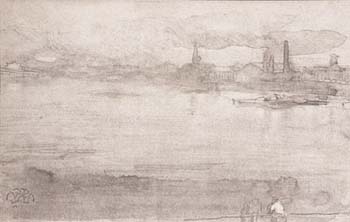Early Morning
- 1878
- James Abbott McNeill Whistler (American 1834-1903)
- Lithotint
16.7 x 26.0 cm., 6-9/16 x 10-1/4" image
- Catherine Carter Goebel, Paul A. Anderson Chair in the Arts Purchase, Paul A. Anderson Art History Collection, Augustana College 99.22

Essay by Carol Marquardsen, Class of 2006
The gentle lithotint, Early Morning (1878), is a highlight in the advent of modernity in nineteenth-century art. Its artist, the eccentric American expatriate, James Abbott McNeill Whistler, was an inimitable figure in his day. Throughout his career of painting and printmaking he acted as an individual, freely associating with various art movements of the late 1800s.
Whistler's interest in harmonious aesthetics, in coordinating all the elements of a work, led him to explore the artistic manipulations possible with printmaking. Once the image is etched into the metal plate, and the ink is wiped into the depths created by the acid treatment, the areas meant to be blank must be wiped clean of excess ink. Lighting effects can be accomplished by doing this selectively, creating an effect of dramatic contrasts in tone called chiaroscuro (Lochnan 60-61). Whistler also varied the hue of his inks from dark browns to blacks, and the quality and effect of his papers.
In 1878, Whistler began collaboration with the printer Thomas Way to use the relatively untested technique of the lithotint, a form of lithography that employed special solvent and pigment washes applied selectively by brush. The result had the fluid gradations of hand-painted monochromatic watercolor, a smoothness comparable to the luxury of velvet. Early Morning is one of six lithotints Whistler completed for publication.
Many of the design elements of Early Morning are shared among Whistler's prints. The simplicity and subtle abstraction of form in this riverside landscape were more typical of his later, more understated works, although early in his career he made a departure from over-embellished Victorian print styles. Also notable for Early Morning is the hazy, passive, rather than didactic, impression of the scene, expressing Whistler's preference for design over content. The elegant balance between positive and negative space, between the inked shorelines and the almost blank sea and sky areas in the distinctly horizontal composition, mimics the design virtues of Japanese woodblock prints and porcelain, which Whistler collected throughout his life (Goebel 19).
